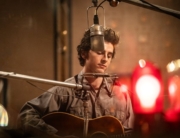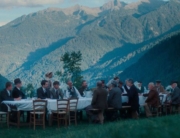I find it almost impossible not to compare The Wall with the recent release of Gravity. Both concern women trapped in arduous and isolating situations, fighting for survival. Both comment on the relationship humans have with nature. Unlike Gravity, The Wall is firmly planted on Earth’s surface.
The nameless protagonist of The Wall is visiting two friends and their dog, Lynx, at their hunting lodge in the Austrian Alps. Upon arrival, the couple decides to make a quick trip into the nearby village, while the woman and Lynx stay behind at the lodge. The two are not back by nightfall. When the woman wakes in the morning, they are still missing. Now worried about what might have happened to her friends, the woman proceeds to make her way down the dirt road towards the village. She is quickly stopped, dead in her tracks, by an invisible and impenetrable wall that surrounds her in the countryside, trapping her.
Initially, her only companion is Lynx, though she does gather other animals such as a cow and two cats. Upon trying to break through the barrier, she notices another cottage on the other side with an elderly couple outside. Upon closer inspection, she determines they are frozen in time—or dead—presumably because of the appearance of the wall. Void of human companionship and a way to escape, the woman resolves to survive in the lodge clinging to her animals, especially Lynx. The relationship between her and the dog is at the heart of the film.
It’s an interesting take on dystopian fiction. Based on the 1963 novel by Marlen Haushofer, the film gives little explanation for the wall’s appearance. While it suggests a kind of science-fiction slant, The Wall’s main focus is on the woman. She narrates the film and is almost a constant presence on screen, either visually or aurally. Actress Martina Gedeck carries the movie splendidly as basically the only human on screen for almost two hours.
While The Wall may not contain the awe-inspiring space-scapes of Gravity, director Julian Roman Pölsler features the Austrian scenery in such a way that it becomes a main character in its own right (six cinematographers are credited, giving one an idea of the work that must have gone into this beautiful looking film). The music score is often interrupted by stretches of complete silence, letting the landscape speak for itself. Perhaps The Wall doesn’t have the intensity of Gravity, but in some ways their similar themes are better situated in the former. Isolation and human’s complex relationship with nature can be depicted just as powerfully right here on Mother Earth.







Leave A Comment